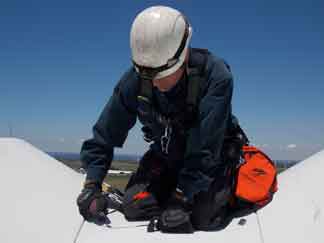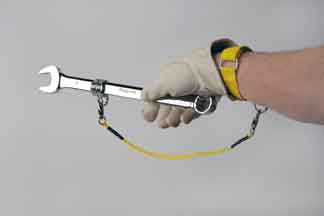Drop Prevention Systems for Tools
Tethered tools can increase safety and productivity
By John Martell
Product Manager, Snap-on Industrial
A tool dropped from an elevated work platform poses immediate danger to personnel and equipment below. While there are federally mandated guidelines for securing people working on surfaces four feet or higher from the ground, there are no such requirements for securing tools. In this article, John Martell discusses the safety reasons of why organizations need to implement some type of tethered tool program. While most organizations recognize the need for systems to prevent worker’s tools from falling, identifying and implementing effective solutions has been challenging for a number of reasons. Fortunately, new technologies have emerged that not only better secure tools while working at height, but also maintain the tool’s full functionality for increased safety and productivity.
 Dropped Tool = Potential for Severe Consequences
Dropped Tool = Potential for Severe Consequences
In any application where work is being performed four feet or more from the ground, or above machinery, implementation of a system to prevent tools from falling is strongly recommended. Whether performing utility system repairs from a boom lift at 40 feet; servicing a cellular transmission tower 150 feet up; or maintaining a nearly 300 foot tall wind turbine, dropped tools pose significant risk to employees and equipment. To put this in perspective: a five pound object falling from a height of 200 feet will strike the ground with about 1,770 pounds of force per square inch. A tool falling from that height can cause serious equipment damage, or more importantly, severely injure or kill someone.
How hazardous are falling objects on work sites? According to the Occupational Safety and Health Administration (OSHA), being struck by a falling object is the fourth leading cause of workplace fatalities (transportation accidents, homicides and people falling are the top three causes of workplace deaths). Dropped objects are probably more common than you think. Nationwide, there were more than 138,000 recorded incidents in 2011. That figure equals 384 dropped objects every day. And that’s just the number recorded. Dropped objects have become such an epidemic that some companies have implemented policies terminating employees responsible for a drop.
There are laws in place to regulate the top three causes of workplace death. These include things like limits to the number of hours a commercial driver can operate a vehicle in a day, along with reduced speed limits in work zones. Certainly there are laws against homicides. And fall protection equipment mandates exist for employees working at elevations of four feet or more.
Surprisingly, no such regulations exist for the fourth leading cause of death. There are a few basic guidelines that industrial sites must follow, such as: workers wearing hard hats; platforms with toe boards to prevent things from getting kicked to the ground; and debris nets to catch falling objects. But these recommendations leave gaps in safety. A hard hat serves as little protection from a tool falling 200 feet. Toe boards can prevent items from being kicked off a platform, but what about a tool that slips from a technician’s hand? And since debris nets are typically porous, small or slender items, such as tools, may not be caught. The best defense is to prevent tools from falling in the first place.
Old Problems…New Ideas
Tethered tools are not a new concept. Tethering devices come in many shapes and sizes, but many fall short for one reason or another. Some mount in a way that limits the full use of the tool, are difficult to handle, and technicians view them as obstructions to productivity. Others work with only a portion of the tools, leaving some unsecured. With that said, the most common complaint of tethered devices is that they inhibit the functionality of the tool. A tool can be tethered, but if a technician refuses to use the device because it’s too cumbersome, then the design fails and the objective of a safer working environment is not reached.
 Engineered Attachment Points
Engineered Attachment Points
New technologies for drop prevention are emerging that focus on maintaining or enhancing a tool’s functionality. An important development is that these new tethering systems are designed in conjunction with the tool, and not looked at as an afterthought. Developing system components independently is what ultimately compromises functionality and inhibits program implementation. Engineered attachment points must consider tool’s design and function in order to maintain or improve use when tethered. And, rigorous drop testing to certify the design of attachment points should be in place to ensure safety. Fortunately there are innovative new offerings that do just that. Here are a few examples:
- Locking Pins - Square drive tools and accessories are designed and manufactured with spring loaded lock buttons in square drives. The lock button engages with side lock holes drilled in sockets, extensions, and adaptors ensuring positive retention. A pin release tool is used to separate components in the system. This method is preferred over using quick release tools because a quick release button or collar can be activated inadvertently causing the drive tools to separate and become dangerous dropped objects.
- Rotating Tabs - Screwdrivers are fitted with stainless steel tabs that rotate freely 360° so lanyards do not get tangled around the users hand or the screwdriver handle. This method also leaves all of the handle surfaces available to be used for power and control.
- Safety Coils - The stainless steel coils are installed on wrenches and slide along the wrench handle out of the way from an operator’s hand. This provides full use of the wrenches handle which provides reach and leverage when needed.
- Strategic Location - Removable jaws on pipe wrenches are pinned or drilled so the jaw cannot be separated from the wrench handle. This is critical because simply attaching to the hang hole already forged into the wrench handle leaves too great a risk of dropping the removable jaw.
Transporting and Using Tools Safely In examining ways to make drop prevention systems better for technicians, industry has studied the most common cause of tool drops – the transfer between storage and use. More than half of drop incidents occur during this frequent action. With most systems, in order to secure a tool, the technician must first retrieve it and then clip or attach it to a lanyard. This process involves both hands and creates potential for dropped tools. This practice is one that required attention. When working at height, technicians should maintain three points of contact for their safety: two feet on a platform and one hand on a secured infrastructure. By using both hands to handle tools and attach the tool to a tethering device, the technician loses one point of contact.
In examining ways to make drop prevention systems better for technicians, industry has studied the most common cause of tool drops – the transfer between storage and use. More than half of drop incidents occur during this frequent action. With most systems, in order to secure a tool, the technician must first retrieve it and then clip or attach it to a lanyard. This process involves both hands and creates potential for dropped tools. This practice is one that required attention. When working at height, technicians should maintain three points of contact for their safety: two feet on a platform and one hand on a secured infrastructure. By using both hands to handle tools and attach the tool to a tethering device, the technician loses one point of contact.
To address this concern, tethering systems have been developed that eliminate the additional actions normally required to secure tools. An example is a tool belt in which each tool has its own pouch or holster with a tethering device already installed. This enables the technician to simply remove the tool, use it, and put it back into its place on the belt – all with one hand. Since every tool is already independently tethered, no device needs to be attached, which removes transferring issues and eliminates drops.
Belts and harnesses can be custom designed to meet specific applications within different industries. Whether Power Generation, Oil & Gas, or Utilities, systems can be designed with the proper tools, and ordered as turn-key solutions with a single part number. Every tool is already installed with its own tethered device and ready to be used: just open the box, put on the belt, and go to work.
Hardware and Small Parts Management
Another innovation can be found in small parts bags. In some industries, like windpower, technicians may carry tools and hardware to the work location in small, belt mounted bags. The most common versions of these bags employ conventional closures which lack durability or could be left open, which may allow the contents to spill out. In the latter case, dropped objects can injure someone or become Foreign Object Debris (FOD). The latest design has a leg strap to secure it upright and in place, along with a self-closing feature that automatically seals the pouch after each use. The opening has a trap-door system that acts as a one-way check valve. When a technician inserts their hand in the bag to retrieve an item, the neoprene flaps part. When the hand is removed, the flaps close and seal the opening. If the pouch happens to be tipped upside down, parts are prevented from escaping. Some models add a strap closure that provides additional security when a technician isn’t actively working from the bag. This innovative solution offers quick access and a much higher level of functionality, while also being more secure than its peers.
Summary
More than 1,000 tools are now available with engineered tether points for drop prevention. By design, the systems do not interfere with functionality or productivity. In addition, with varying needs across industries, custom, turn-key solutions, such as the tool belt referenced above, make drop prevention programs more robust and simplify procurement. As tool drop prevention systems continue to evolve, productivity and efficiencies will increase. Safety is the No. 1 objective on any work site, and eliminating dropped tools goes a long way toward achieving a safe work environment.
John Martell is a Product Manager at Snap-on Industrial. He can be reached at 262-656-5337, or email: john.a.martell@snapon.com.












